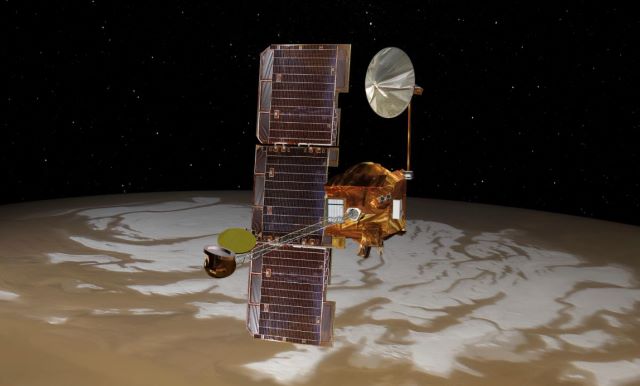
A NASA spacecraft celebrated a special birthday recently. The Mars Odyssey orbiter launched with the Arizona State University (ASU)-led Thermal Emission Imaging System on board in April of 2001. According to Karin Valentine at ASU’s School of Earth and Space Exploration, the Odyssey orbiter spacecraft has sent back more than 1 million images since it began circling Mars.
Not only have those images and the maps it’s produced helped missions figure out what parts of Mars they want to study up close, but it’s also helped NASA decide where to land its Mars missions – including the Perseverance rover, which touched down on Feb. 18, 2021.
“In the past 40 years Mars has gone from a red dot in the sky to a world we have come to know almost as well as our own,” Professor Philip Christensen told Valentine and Andrew Good of NASA’s Jet Propulsion Laboratory. “Mars Odyssey and THEMIS have played a major role in that transformation and it has been a great privilege to have been part of the exploration of Mars.”
Christensen is a geology and geophysics professor in the School of Earth and Space Exploration at Arizona State University. He has built five science instruments that have flown on NASA missions to Mars, including the Thermal Emission Imaging System (THEMIS) camera on Mars Odyssey.
The THEMIS has made possible two decades of data with complete global maps of Mars. These maps have allowed scientists to chart valley networks and craters, map water ice, spot sandstone, volcanic rocks, and clays, and lend deeper insight to Mars’ story.
In June 2020, the Arizona State University team published three views of Phobos, capturing the moon as it drifted in and out of Mars’ shadow. Studying each moon’s thermophysics helps scientists determine the properties of materials on their surfaces, just as they did for the Martian surface.
ASU Mars scientist Jonathon Hill compiled 24,000 individual images taken by THEMIS to design a basketball court-sized map of Mars. The map can be transported to schools and events so science enthusiasts of all ages can “walk” on Mars. The map has even traveled to the National Mall in Washington, D.C., where visitors could take a stroll on the red planet, go on a geographical scavenger hunt and talk to Mars scientists.
“Mars is a very dynamic and changing place, so we hope that THEMIS and Odyssey will continue to observe the planet for many more years to come,” said Christensen. “Exploration always has surprises, so even after 20 years we never really know what to expect in each image we take.”
THEMIS was built and is operated by ASU. Odyssey’s Gamma Ray Spectrometer was provided by the University of Arizona, Tucson, Los Alamos National Laboratory, and the Russian Space Research Institute. The prime contractor for the Odyssey project, Lockheed Martin Space in Denver, developed and built the orbiter. Mission operations are conducted jointly from Lockheed Martin and from the
NASA Jet Propulsion Laboratory (JPL), a division of Caltech in Pasadena.
The U.S. Army Corps of Engineers has been tasked with…
Brown and Caldwell, a leading environmental engineering and construction firm,…
Humboldt State University, one of four campuses within the California…